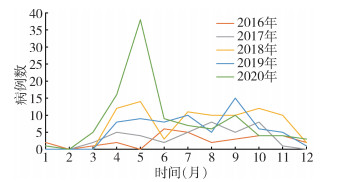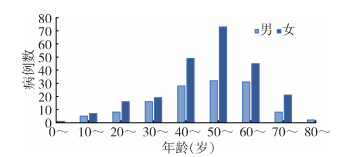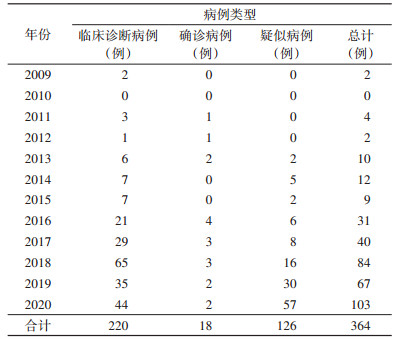扩展功能
文章信息
- 杨瑞, 谢艳琼, 刘力, 姚璇
- YANG Rui, XIE Yan-qiong, LIU Li, YAO Xuan
- 湖北省2009-2020年恙虫病报告病例流行病学特征分析
- Epidemiological characteristics of scrub typhus cases reported in Hubei province, China, 2009-2020
- 中国媒介生物学及控制杂志, 2022, 33(4): 543-547
- Chin J Vector Biol & Control, 2022, 33(4): 543-547
- 10.11853/j.issn.1003.8280.2022.04.019
-
文章历史
- 收稿日期: 2021-12-30
2 咸丰县疾病预防控制中心, 湖北 恩施 445600
2 Xianfeng County Center for Disease Control and Prevention, Xianfeng, Hubei 445600, China
恙虫病,又名丛林斑疹伤寒,是由恙虫病东方体(Orientia tsutsugamushi,Ot)引起的自然疫源性疾病。以鼠类为主要传染源,以恙螨(chigger mite)幼虫为传播媒介。临床上以发热、焦痂或溃疡、淋巴结肿大及皮疹为主要特征,发生严重并发症可导致死亡[1]。至20世纪80年代中期,我国恙虫病主要分布于东南、西南地区及沿海岛屿;自1986年以来疫区迅速扩展,并向长江以北蔓延,山东、江苏、河南、天津等地先后发现恙虫病流行[2-4]。中国疾病预防控制信息系统监测发现,湖北省自2009年开始有恙虫病疫情报告,近5年来,湖北省恙虫病的发病率持续升高,为进一步了解湖北省恙虫病发病水平及流行特点,掌握疫情的动态变化,为今后制定预防与控制措施提供依据,本文对2009-2020年湖北省恙虫病监测数据进行分析总结。
1 材料与方法 1.1 资料来源从中国疾病预防控制信息系统下载2009年1月1日至2020年12月31日湖北省恙虫病报告病例,按照现住址、发病日期及已终审卡统计,主要包括性别、年龄、职业、现住地址地理编码、发病时间、诊断时间和报卡时间等。人口学资料来自湖北省统计年鉴。
1.2 恙虫病诊断标准根据《恙虫病预防控制技术指南(试行)》[5]中的诊疗要求,结合病例的流行病学史、临床表现和实验室检测结果进行诊断,病例类型分为确诊病例、临床诊断病例和疑似病例。
1.3 统计学分析Excel 2010软件用于整理数据,采用ArcGIS 10.3软件建立恙虫病病例数的地理信息数据库并绘制病例分布地图。SPSS 19.0软件中的χ2检验比较发病率在时间、地区和性别之间的差异,P < 0.05为差异有统计学意义。
2 结果 2.1 疫情概况2009-2020年湖北省累计报告恙虫病364例,平均发病率为0.05/10万。其中2016-2020年平均发病率均高于2009-2015年平均发病率(0.01/10万),2020年发病率达0.17/10万,是2019年发病率(0.004/10万)的42.5倍(图 1)。2016年报告1例男性死亡病例(临床诊断病例),病死率为0.27%。

|
| 图 1 2009-2020年湖北省恙虫病病例报告情况 Figure 1 Cases of scrub typhus reported in Hubei province, 2009-2020 |
| |
恙虫病的发病时间主要集中在4-10月,累计占86.81%(316/364),在4月中旬病例数开始上升,10月中旬病例数开始下降,2020年5月病例达38例。见图 2。

|
| 注:2009-2015年每年的发病数均较少,7年共计39例,未在图中显示。 图 2 2016-2020年湖北省恙虫病报告病例逐月分布 Figure 2 Monthly distribution of cases of scrub typhus reported in Hubei province, 2016-2020 |
| |
2009年湖北省仅有2个县(区、市)有恙虫病病例报告,到2020年全省累计15个市(州)61个县(区、市)有病例报告(图 3),病例主要来自恩施土家族苗族自治州(恩施州)(136例)、十堰市(125例)、黄冈市(51例),占总病例数的85.71%(312/364);发病率排前3位的分别是恩施州(4.05/10万)、十堰市(3.67/10万)和黄冈市(0.81/10万)。3个高发地区病例发病率差异有统计学意义(χ2=128.674,P < 0.001)。

|
| 图 3 2009-2020年湖北省恙虫病报告病例地区分布 Figure 3 Geographical distribution of cases of scrub typhus reported in Hubei province, 2009-2020 |
| |
364例病例中,男性131例,女性233例,男女性别比例为1∶1.78;各年龄组均有发病(图 4),30~79岁年龄组累计占88.46%(322/364),其中40~69岁年龄组占70.88%(258/364),20岁以下年龄组占3.85%(14/364),各年龄组发病构成差异有统计学意义(χ2=136.104,P < 0.001);报告病例年龄最小2岁,最大83岁。

|
| 图 4 2009-2020年湖北省恙虫病报告病例的年龄与性别分布 Figure 4 Age and sex distribution of cases of scrub typhus reported in Hubei province, 2009-2020 |
| |
报告病例以农民为主,占69.50%(253/364),其次为家务及待业,占9.62%(35/364),其他职业病例占20.88%(76/364)。
2.5 发病至诊断时间、报告卡录入及县(区、市)审核时间情况2009-2013年仅报告8例恙虫病病例,未做中位数分析。2013-2020年报告病例发病至诊断所需时间最短为0 d(37例),最长为35 d(1例),中位数为5 d,发病至确诊时间间隔中位数逐年缩短(表 1)。诊断时间至报告卡录入时间0 d占71.43%(260/364),1 d占28.57%(104/364);报告卡录入时间至县(区、市)审核时间0 d占93.68%(341/364),1 d占6.32%(23/364)。

|
累计报告恙虫病病例364例,其中临床诊断病例占60.44%(220/364)、确诊病例占4.94%(18/364)、疑似病例占34.62%(126/364)。见表 2。

|
三甲综合性医院报告152例(确诊病例17例、临床诊断病例64例、疑似病例71例),占41.76%;县级综合性医院报告212例(确诊病例1例、临床诊断病例156例、疑似病例55例),占58.24%。报告1、2及3例恙虫病的医生分布在全省不同医院,报告4例病例以上的医生占12.00%(24/200),主要集中在十堰市、恩施州和黄冈市英山县。
3 讨论根据2009-2020年湖北省恙虫病报告病例数据分析,全省恙虫病发病率整体呈上升趋势,发病地区扩散速度较快,整体呈散发态势。李贵昌等[6]和王玉姣等[7]对我国恙虫病夏季型和秋季型疫区划分研究分析,湖北省属于南北疫区中间的过渡地带,属于夏秋型分布,主要集中在恩施州、十堰市等山区地带;发病人群主要集中在40~70岁,男性少于女性,职业以农民为主[8-10],分析其可能原因有两点:一是湖北省的恩施州、十堰市等山区地带的自然生态环境适宜北社鼠(Niviventer confucianus)、黄胸鼠(Rattus tanezumi)等恙虫病自然宿主生存和恙螨生长繁殖[11-13];二是5和9月是农忙时节,农民野外劳作多,增加了与传播媒介的接触机会[14-16];2020年5月有1个显著的发病高峰,可能与2020年4月湖北省气温回暖,湿度增加,适合鼠、恙螨等媒介的繁殖和生长有关。尽管当时湖北省新型冠状病毒肺炎疫情全面解封,但很多外出务工农民暂留本地,开始整理田地等野外活动,增加了恙虫病感染风险。
根据2013-2020年报告病例发病至诊断时间分析结果提示,时间间隔中位数整体呈逐年缩短的趋势,这可能与当地疾控机构对传染病防治宣传教育的重视,及随着生活水平的提高,人群健康意识不断增强,从而促进了人群就医行为的实现有关。
湖北省恙虫病病例报告主要来自县级综合性医院,报告病例类型主要为临床诊断病例和疑似病例,尤其是近5年来,临床诊断病例和疑似病例的构成比逐年升高,实验室确诊病例比例较低。分析其原因可能与基层医疗机构对恙虫病实验室检测技术不普及,临床医生通过患者流行病史、临床症状及体征,进行诊断性用药治疗,患者病情治愈或好转即诊断为临床诊断病例有关。根据临床医生报告病例情况分析,有24名医生平均每位报告病例数超过4例,因此不排除有的临床医生根据自己的诊疗习惯进行诊断,存在误诊和漏诊的可能。
综上所述,针对湖北省恙虫病流行特征,建议采取以下措施:一是在疫情高发地区加强对鼠、螨密度的监测,在鼠类活动频繁场所布放鼠夹、灭鼠药,改善周围环境卫生[17],减少鼠、螨生存和繁殖的条件,防止疫源地的扩大;二是加强医疗机构临床医生恙虫病知识培训,同时应提高基层医疗机构恙虫病实验室检测能力,提高诊断率,减少恙虫病误诊、漏诊,做到早发现、早报告、早处置[18];三是在流行季节,加强对重点人群做好恙虫病的防治健康宣传教育,普及农民在野外活动做好个人防护[19-20],同时避免在草丛或灌木中坐卧、休息等。
利益冲突 无
| [1] |
李兰娟, 任红. 传染病学[M]. 8版. 北京: 人民卫生出版社, 2013: 141-142. Li LJ, Ren H. Infectious diseases[M]. 8th ed. Beijing: People's Medical Publishing House, 2013: 141-142. |
| [2] |
李贵昌, 刘起勇. 恙虫病的流行现状[J]. 疾病监测, 2018, 33(2): 129-138. Li GC, Liu QY. Epidemic trend of scrub typhus in the world[J]. Dis Surveill, 2018, 33(2): 129-138. DOI:10.3784/j.issn.1003-9961.2018.02.006 |
| [3] |
岳玉娟, 王玉姣, 李贵昌, 等. 2006-2018年中国大陆恙虫病高发区流行病学特征分析[J]. 疾病监测, 2020, 35(4): 301-306. Yue YJ, Wang YJ, Li GC, et al. Epidemiological characteristics of scrub typhus in high-incidence areas in the mainland of China, 2006-2018[J]. Dis Surveill, 2020, 35(4): 301-306. DOI:10.3784/j.issn.1003-9961.2020.04.007 |
| [4] |
龚健仁. 我国恙虫病的分布状况与研究概况[J]. 中华疾病控制杂志, 2016, 20(11): 1176-1181. Gong JR. The distribution and general situation on epidemiology studies of tsutsugamushi disease in China[J]. Chin J Dis Control Prev, 2016, 20(11): 1176-1181. DOI:10.16462/j.cnki.zhjbkz.2016.11.025 |
| [5] |
中国疾病预防控制中心. 恙虫病预防控制技术指南(试行)[Z]. 北京: 中国疾病预防控制中心, 2009. Chinese Center for Disease Control and Prevention. Technical guidelines for the prevention and control of tsutsugamushi disease (trial)[Z]. Beijing: Chinese Center for Disease Control and Prevention, 2009. (in Chinese) |
| [6] |
李贵昌, 王玉姣, 岳玉娟, 等. 我国恙虫病夏季型和秋季型疫区划分研究[J]. 中国媒介生物学及控制杂志, 2019, 30(3): 233-236. Li GC, Wang YJ, Yue YJ, et al. Division of epidemic areas for summer-and autumn-type scrub typhus in China[J]. Chin J Vector Biol Control, 2019, 30(3): 233-236. DOI:10.11853/j.issn.1003.8280.2019.03.001 |
| [7] |
王玉姣, 闫冬明, 李贵昌, 等. 北京市平谷区2008-2018年恙虫病流行特征分析[J]. 中国媒介生物学及控制杂志, 2019, 30(3): 244-247. Wang YJ, Yan DM, Li GC, et al. Epidemiological characteristics of scrub typhus in Pinggu district of Beijing, China, in 2008-2018[J]. Chin J Vector Biol Control, 2019, 30(3): 244-247. DOI:10.11853/j.issn.1003.8280.2019.03.003 |
| [8] |
苏静静, 王莹, 周娟, 等. 近年来我国恙虫病流行病学研究进展[J]. 中华卫生杀虫药械, 2012, 18(2): 160-163. Su JJ, Wang Y, Zhou J, et al. Advances in research of tsutsugamushi disease epidemiology in China in recent years[J]. Chin J Hyg Insect Equip, 2012, 18(2): 160-163. DOI:10.19821/j.1671-2781.2012.02.026 |
| [9] |
吴义城. 我国大陆地区恙虫病时空特征分析及风险预测研究[D]. 北京: 中国人民解放军军事医学科学院, 2016. Wu YC. Study on spatiotemporal dynamics and risk prediction of scrub typhus in China's mainland[D]. Beijing: Academy of Military Medical Sciences, 2016. (in Chinese) |
| [10] |
张萌, 王显军, 赵仲堂. 中国恙虫病流行态势及预防控制[J]. 中华流行病学杂志, 2011, 32(4): 419-423. Zhang M, Wang XJ, Zhao ZT. Current epidemic status and issues on prevention and control of scrub typhus[J]. Chin J Epidemiol, 2011, 32(4): 419-423. DOI:10.3760/cma.j.issn.0254-6450.2011.04.021 |
| [11] |
邹波, 郭永旺, 侯玉, 等. 平顺县北社乡晚秋农田鼠类分布和数量配置[J]. 山西农业科学, 2012, 40(9): 976-978, 982. Zou B, Guo YW, Hou Y, et al. Distribution investigation and the number of configuration of the farmland rodents in late autumn of Beishe town, Pingshun county[J]. J Shanxi Agric Sci, 2012, 40(9): 976-978, 982. DOI:10.3969/j.issn.1002-2481.2012.09.15 |
| [12] |
李贵昌, 王玉姣, 母群征, 等. 北京市平谷区恙虫病自然疫源地宿主、媒介和病原体调查[J]. 中国媒介生物学及控制杂志, 2021, 32(3): 291-297. Li GC, Wang YJ, Mu QZ, et al. An investigation of the hosts, vectors, and pathogens of scrub typhus in Pinggu natural focus of Beijing, China[J]. Chin J Vector Biol Control, 2021, 32(3): 291-297. DOI:10.11853/j.issn.1003.8280.2021.03.007 |
| [13] |
谭梁飞, 熊进峰, 张令要, 等. 湖北省发热伴血小板减少综合征发病地区鼠形动物种群构成调查[J]. 中国媒介生物学及控制杂志, 2013, 24(4): 348-349, 352. Tan LF, Xiong JF, Zhang LY, et al. Species composition of murine-like animals in epidemic areas of severe fever with thrombocytopenia syndrome in Hubei province, China[J]. Chin J Vector Biol Control, 2013, 24(4): 348-349, 352. DOI:10.11853/j.issn.1003.4692.2013.04.021 |
| [14] |
吴光华, 王长军, 李丙军, 等. 我国恙虫病宿主动物的研究概况[J]. 中华卫生杀虫药械, 2013, 19(5): 370-373. Wu GH, Wang CJ, Li BJ, et al. General situation on studies of animal hosts of tsutsugamushi disease in China[J]. Chin J Hyg Insect Equip, 2013, 19(5): 370-373. DOI:10.19821/j.1671-2781.2013.05.002 |
| [15] |
姜志宽, 吴光华, 李丙军, 等. 我国秋冬型恙虫病媒介恙螨的研究概况[J]. 中华卫生杀虫药械, 2013, 19(6): 473-477. Jiang ZK, Wu GH, LI BJ, et al. General situation of studies on vector chigger mite of tsutsugamushi disease of autumn-winter type in China[J]. Chin J Hyg Insect Equip, 2013, 19(6): 473-477. DOI:10.19821/j.1671-2781.2013.06.004 |
| [16] |
Kuo CC, Huang JL, Ko CY, et al. Spatial analysis of scrub typhus infection and its association with environmental and socioeconomic factors in Taiwan[J]. Acta Trop, 2011, 120(1/2): 52-58. DOI:10.1016/j.actatropica.2011.05.018 |
| [17] |
袁庆虹, 陈敏, 杨向东. 云南省2006-2017年恙虫病流行病学分析[J]. 中国媒介生物学及控制杂志, 2018, 29(6): 613-616. Yuan QH, Chen M, Yang XD. Epidemiological analysis of scrub typhus in Yunnan province during 2006-2017[J]. Chin J Vector Biol Control, 2018, 29(6): 613-616. DOI:10.11853/j.issn.1003.8280.2018.06.015 |
| [18] |
李贵昌, 栗冬梅, 李焱, 等. 2006-2016年我国恙虫病流行特征分析[J]. 疾病监测, 2018, 33(2): 139-143. Li GC, Li DM, Li Y, et al. Epidemiology of scrub typhus in China, 2006-2016[J]. Dis Surveill, 2018, 33(2): 139-143. DOI:10.3784/j.issn.1003-9961.2018.02.007 |
| [19] |
李贵昌, 李永香, 陈传伟, 等. 河南省永城市恙虫病自然疫源地调查研究[J]. 中国媒介生物学及控制杂志, 2019, 30(3): 255-258. Li GC, Li YX, Chen CW, et al. An investigation of natural focus of scrub typhus in Yongcheng, Henan province, China[J]. Chin J Vector Biol Control, 2019, 30(3): 255-258. DOI:10.11853/j.issn.1003.8280.2019.03.006 |
| [20] |
李文, 马德龙, 赵嘉欣, 等. 广东省恙虫病流行特征及发病风险预测[J]. 中国媒介生物学及控制杂志, 2021, 32(3): 334-338. Li W, Ma DL, Zhao JX, et al. Epidemiological characteristics and risk prediction of scrub typhus in Guangdong province, China[J]. Chin J Vector Biol Control, 2021, 32(3): 334-338. DOI:10.11853/j.issn.1003.8280.2021.03.015 |
 2022, Vol. 33
2022, Vol. 33


